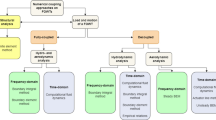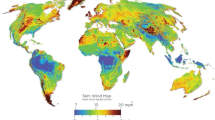Abstract
In recent years, the exploitation of offshore wind resources has been attached with greater importance. As a result, semi-submersible floating wind turbines (FWTs) have gradually become a popular research topic, with the structural strength being a research hotspot as it can ensure the safe operation of FWTs. The severe sea conditions of freak waves result in enormous wave heights, extremely fast wave speeds, and concentrated energy. Thus, it is difficult to accurately simulate these effects on the loads of floating wind turbines using the potential flow theory and other theories. In this paper, the structural strength of a floating wind turbine under the action of freak waves is analyzed based on the CFD-FEA coupled method. The effects of the mooring system and the wind load are considered in the time domain, and the CFD method is applied to analyze the wave load of the floating wind turbine under the extreme sea state of freak waves. The strength and motion of the floating wind turbine float structure are analyzed by combining the CFD method and the FEA method, and the analytical results of the mutual transfer of these two methods are taken as the initial quantities for further analysis. The accuracy of the analytical model of the CFD-FEA method is verified by the results of the tank test analysis, and the structural strength analysis under freak wave conditions is carried out for a new type of floating wind turbine. The results of this research provide useful guidance and references for the design and engineering applications of offshore floating wind turbines.
Similar content being viewed by others
References
American Bureau of Shipping (ABS), 2009. Guide for Building and Classing Floating Production Installations, American Bureau of Shipping.
Chen, Z.W., Jiao, J.L., Wang, Q. and Wang, S., 2022. CFD-FEM simulation of slamming loads on wedge structure with stiffeners considering hydroelasticity effects, Journal of Marine Science and Engineering, 10(11), 1591.
Cheng, Y., Du, W.M., Dai, S.S., Ji, C.Y., Collu, M., Cocard, M., Cui, L., Yuan, Z.M. and Incecik, A., 2022a. Hydrodynamic characteristics of a hybrid oscillating water column-oscillating buoy wave energy converter integrated into a π-type floating breakwater, Renewable and Sustainable Energy Reviews, 161, 112299.
Cheng, Y., Fu, L., Dai, S.S., Collu, M., Ji, C.Y., Yuan, Z.M. and Incecik, A., 2022b. Experimental and numerical investigation of WEC-type floating breakwaters: A single-pontoon oscillating buoy and a dual-pontoon oscillating water column, Coastal Engineering, 177, 104188.
Cheng, Y., Fu, L., Dai, S.S., Collu, M., Cui, L., Yuan, Z.M. and Incecik, A., 2022c. Experimental and numerical analysis of a hybrid WEC-breakwater system combining an oscillating water column and an oscillating buoy, Renewable and Sustainable Energy Reviews, 169, 112909.
Gao, J.L., Lyu, J., Wang, J.H., Zhang, J., Liu, Q., Zang, J. and Zou, T., 2022. Study on transient gap resonance with consideration of the motion of floating body, China Ocean Engineering, 36(6), 994–1006.
Gao, J.L., Lyu, J., Zhang, J. and Zang, J., 2023. Influences of floater motion on gap resonance triggered by focused wave groups, China Ocean Engineering, 37(4), 685–697.
Gao, J.L., Mi, C.L., Song, Z.W. and Liu, Y.Y., 2024. Transient gap resonance between two closely-spaced boxes triggered by nonlinear focused wave groups, Ocean Engineering, 305, 117938.
Huang, S.X., Jiao, J.L. and Soares, C.G., 2022. Uncertainty analyses on the CFD-FEA co-simulations of ship wave loads and whipping responses, Marine Structures, 82, 103129.
Huo, F.L., Zhao, Y.P., Zhang, J.X., Zhang, M. and Yuan, Z.M., 2023. Study on wave slamming characteristics of a typical floating wind turbine under freak waves, Ocean Engineering, 269, 113464.
Jiao, J.L., Huang, S.X., Tezdogan, T., Terziev, M. and Soares, C.G., 2021. Slamming and green water loads on a ship sailing in regular waves predicted by a coupled CFD-FEA approach, Ocean Engineering, 241, 110107.
Lakshmynarayanana, P.A. and Temarel, P., 2020. Application of a two-way partitioned method for predicting the wave-induced loads of a flexible containership, Applied Ocean Research, 96, 102052.
Liu, Y., 2014. A Structural Strength Analysis Method for Spar Type Floating Offshore Wind Turbine, MSc. Thesis, Shanghai Jiaotong University, Shanghai. (in Chinese)
Ma, S.Y. and Mahfuz, H., 2012. Finite element simulation of composite ship structures with fluid structure interaction, Ocean Engineering, 52, 52–59.
Sun, Z., Yin, H.H., Zhang, G.Y. and Zong, Z., 2019. Time-domain 3D hydroelasticity computation based on modified MPS method, Journal of Ship Mechanics, 23(8), 948–956. (in Chinese)
Takami, T., Matsui, S., Oka, M. and Iijima, K., 2018. A numerical simulation method for predicting global and local hydroelastic response of a ship based on CFD and FEA coupling, Marine Structures, 59, 368–386.
Tang, Y.G., Wang, H., Tao, H.C. and Liu, Z.B., 2013. Structure design and global strength analysis for semi-submersible floating foundation of offshore wind turbine, Shipbuilding of China, 54(3), 85–93. (in Chinese)
Wang, J.W., Wang, Y.Q., Guo, R., Cai, W. and Zhao, J.Y., 2022. Dynamic responses of TLP considering coupled transverse and axial effect of tether under second-order wave and freak wave, Journal of Marine Science and Technology, 27(2), 1084–1103.
Yang, H.K., 2022. Design and Motion Characteristics of A New Floating Wind Turbine System, MSc. Thesis, Jiangsu University of Science and Technology, Zhenjiang. (in Chinese)
Zhang, H.R., Tang, W.Y., Yuan, Y.C., Xue, H.X. and Qin, H., 2022. The three-dimensional green-water event study on a fixed simplified wall-sided ship under freak waves, Ocean Engineering, 251, 111096.
Zhao, X.Z., Sun, Z.C. and Liang, S.X., 2008. Focusing models for generating freak waves, Chinese Journal of Theoretical and Applied Mechanics, 40(4), 447–454. (in Chinese)
Author information
Authors and Affiliations
Corresponding author
Ethics declarations
The authors declare no competing interests.
Additional information
Foundation item: This work is financially supported by the National Natural Science Foundation of China (Grant Nos. 52071161 and 52301322), and the Jiangsu Provincial Natural Science Foundation (Grant No. BK20220653).
Rights and permissions
About this article
Cite this article
Huo, Fl., Luo, P., Nie, Y. et al. Structural Strength Study of A Floating Wind Turbine Under Freak Waves Through the CFD-FEA Method. China Ocean Eng (2024). https://doi.org/10.1007/s13344-024-0073-3
Received:
Revised:
Accepted:
Published:
DOI: https://doi.org/10.1007/s13344-024-0073-3




